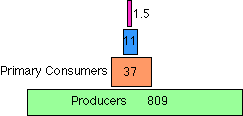| Index to this page |
Such a path of food consumption is called a food chain.
Each level of consumption in a food chain is called a trophic level.
The table gives one example of a food chain and the trophic levels represented in it.| Grass → |
Grasshopper → |
Toad → |
Snake → |
Hawk → |
Bacteria of decay |
| In general, | |||||
| Autotrophs (Producers) → |
Herbivores (Primary Consumers) → |
Carnivores (Secondary, tertiary, etc. consumers) → |
Decomposers | ||
Most food chains are interconnected. Animals typically consume a varied diet and, in turn, serve as food for a variety of other creatures that prey on them. These interconnections create food webs.

H. T. Odum analyzed the flow of energy through a river ecosystem in Silver Springs, Florida.
His findings are shown here. The figures are given in kilocalories per square meter per year (kcal/m2/yr).
At each trophic level,Animal husbandry often exceeds this 10% value. For example, broilers (young chickens) can gain half a pound (227 g) of weight for every pound (454 g) of food they eat. (Since the water content of the two is not the same, the conversion efficiency is somewhat less than the apparent 50%.) Nonetheless, the loss of energy as it passes from producers to primary consumers explains, for example, why it costs more to buy a pound of beefsteak than a pound of corn.
Conversion efficiencies from primary consumers to secondary consumers (herbivores to carnivores) tend to be much lower, averaging about 1%.

Conversions efficiencies are always much less than 100%. At each link in a food chain, a substantial portion of the sun's energy — originally trapped by a photosynthesizing autotroph — is dissipated back to the environment (ultimately as heat).
Thus it follows that the total amount of energy stored in the bodies of a given population is dependent on its trophic level.
For example, the total amount of energy in a population of toads must necessarily be far less than that in the insects on which they feed.
The insects, in turn, have only a fraction of the energy stored in the plants on which they feed.
This decrease in the total available energy at each higher trophic level is called the pyramid of energy.
Using Odum's data on net productivity at the various levels in Silver Springs, we get this pyramid. The figures represent net production at each trophic level expressed in kcal/m2/yr.
| Some ingested materials, e.g., fat-soluble pesticides like DDT, tend not to be dissipated back to the environment. As they pass from one trophic level to the next, their concentration in living tissue actually increases. Link to an example. |

How does one measure the amount of energy in a population?
Since all organisms are made of roughly the same organic molecules in similar proportions, a measure of their dry weight is a rough measure of the energy they contain.
A census of the population, multiplied by the weight of an average individual in it, gives an estimate of the weight of the population. This is called the biomass (or standing crop).
This, too, diminishes with the distance along the food chain from the autotrophs which make the organic molecules in the first place.The graphic shows the pyramid of biomass for Silver Springs. (It, too, is based on the data obtained by Howard T. Odum.) The figures represent the dry weight of organic matter (per square meter) at the time of sampling.
Analysis of various ecosystems indicates that those with squat biomass pyramids (with conversion efficiencies between one trophic level and the next averaging 10% or better) are less likely to be disrupted by physical or biotic changes than those with tall, skinny pyramids (having conversion efficiencies less than 10%).Small animals are more numerous than larger ones. This graph shows the pyramid of numbers resulting when a census of the populations of autotrophs, herbivores, and two levels of carnivores was taken on an acre (0.4 hectare) of grassland. The figures represent number of individuals counted at each trophic level. The pyramid is based on data acquired by Evans, Cain, and Walcott, and has been redrawn by permission from E. P. Odum, Fundamentals of Ecology, 2nd. ed., © W. B. Saunders Co., Philadelphia, 1959.
 The pyramid arises because;
The pyramid arises because;
| Welcome&Next Search |